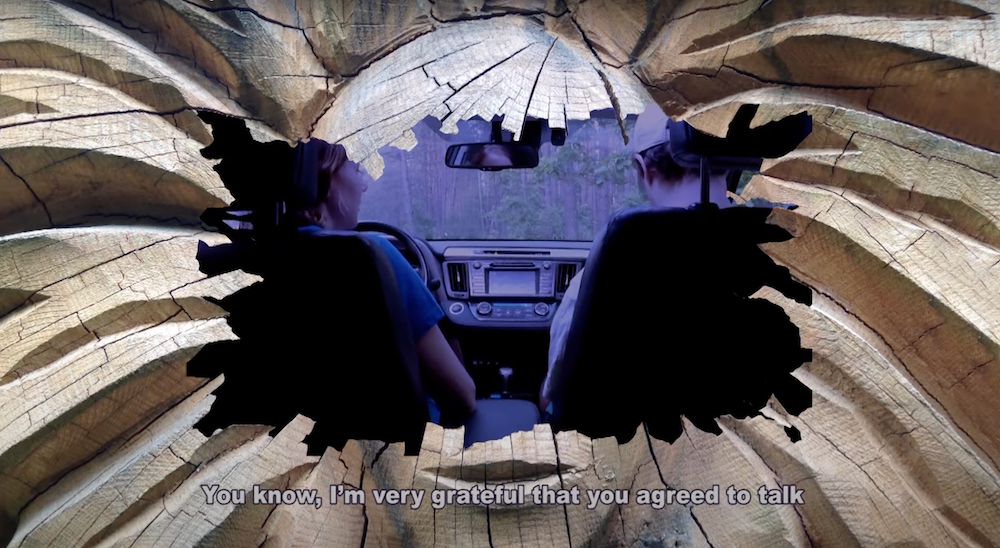Above image: Anastasia Sosunova, Agents, 2020 (still). Video, color, sound; 14:57 min. Courtesy the artist. Video commissioned for “Roots to Routes,” 2020, curated by Juste Kostikovaite, Maija Rudovska and Merilin Talumaa, with the support of the Baltic Culture Fund.
This article was originally published in Whitehot Magazine of Contemporary Art.
By Alexandra Goldman
17 August, 2021
The Screens Series, “a platform for the presentation of new video works by emerging contemporary artists,” is a hidden gem tucked in the basement of The New Museum. Its current iteration, “Screens Series: Anastasia Sosunova” curated by Gary Carrion-Murayari, comprises three videos by Sosunova (b. 1993, Ignalia, Lithuania). Her 14:26 minute video titled, “Agents”, 2020, looks critically at the idea of tradition, questions reality, and considers the role of the artist as filmmaker, philosopher, craftsperson, and creator of tradition.
The New Museum notes, “Sousnova’s recent works have explored popular folk traditions, post-Soviet national identity, and the tension between public and private space in the Covid-era, among many other topics. [Her videos] mix historical research and creative fiction to examine tenuously constructed feelings of community and belonging.” With “Agents”, Sosunova channels universal ideas through a hyper-local scenario.
“Agents” opens with a scene of a woman and man driving a car slowly into the woods. They park amidst the trees, as if in a horror movie. The two engage in whispering a conversation in what I’d imagine is Lithuanian, with English subtitles. The conversation is noted at the start of the film to have been scripted for artistic purposes. Viewers find out later in the film that the forest was one of the only places people were allowed to go outside during Covid-19 quarantine in Lithuania. Music is playing.
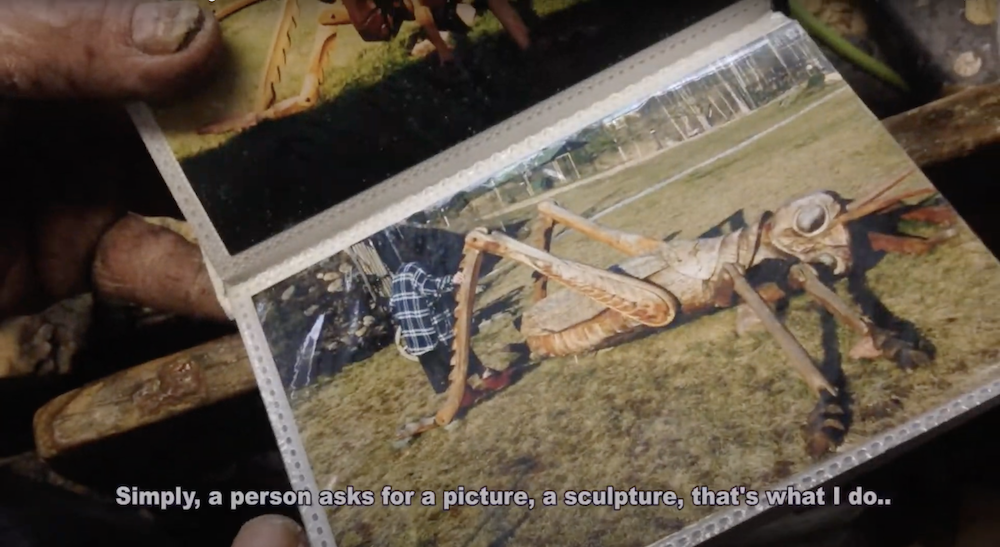
Anastasia Sosunova, Agents, 2020 (still). Video, color, sound; 14:57 min. Courtesy the artist. Video commissioned for “Roots to Routes,” 2020, curated by Juste Kostikovaite, Maija Rudovska and Merilin Talumaa, with the support of the Baltic Culture Fund.
“We should turn it off, otherwise, we’ll scare them,” the woman says. While watching, I imagined the woman, who is in the driver’s seat, to be Sosunova. The man in the passenger’s seat seems to be a Lithuanian folk sculptor (or an actor playing one) – in other words, it could be argued that, in this filmed conversation, he, the craftsperson, is the “artist”, while the artist, Sosunova, is the “interviewer”. The woman continues, “You know, I’m very grateful that you agreed to talk in these circumstances. I thought at some point the things we create live their own lives, one can even say they come to life, and I begin to think of folk art conspiratorially.”
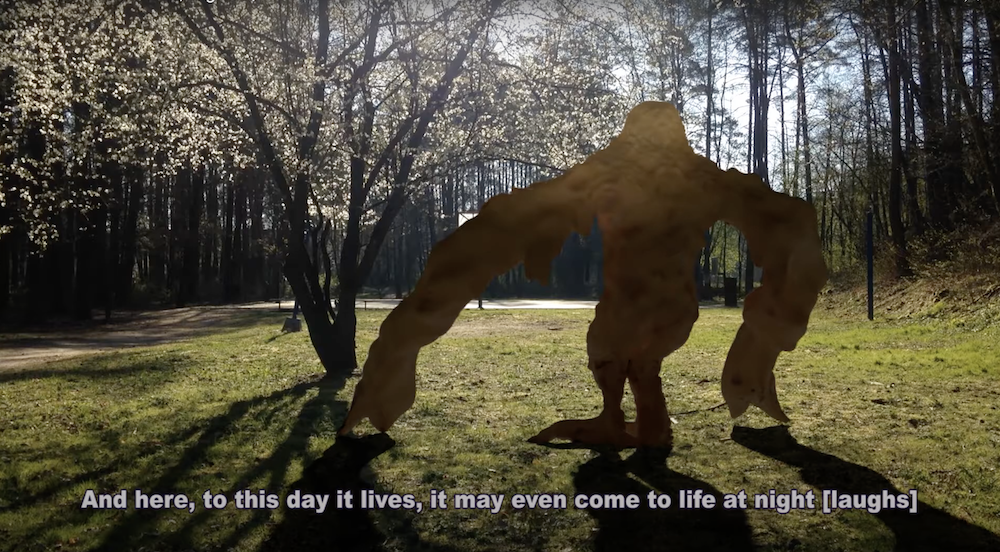
Anastasia Sosunova, Agents, 2020 (still). Video, color, sound; 14:57 min. Courtesy the artist. Video commissioned for “Roots to Routes,” 2020, curated by Juste Kostikovaite, Maija Rudovska and Merilin Talumaa, with the support of the Baltic Culture Fund.
Sosunova immediately places the viewer in a cinematic vantage point mediated by fantasy, inducing a required suspension of disbelief. The protagonists are shot through what looks like a blasted hole in the middle of a strange animated wooden totem face framing their Socratic conversation. Both protagonists remain fairly anonymous throughout the duration of the film, as they are only shot with one camera angle from behind, revealing the backs of their heads and a slight profile at most, creating a disorienting effect. Viewers of the film get to know these characters mostly through their voices, dialogue, the deliberateness with which they speak, and their mutual respect for the conversation at hand. Viewers also get to know the sculptor through alternating camera shots of his weathered hands and dirty fingernails, that have surely been carving wood for decades, flipping through old photo albums of crafts and sculptures he either has created or references for inspiration.
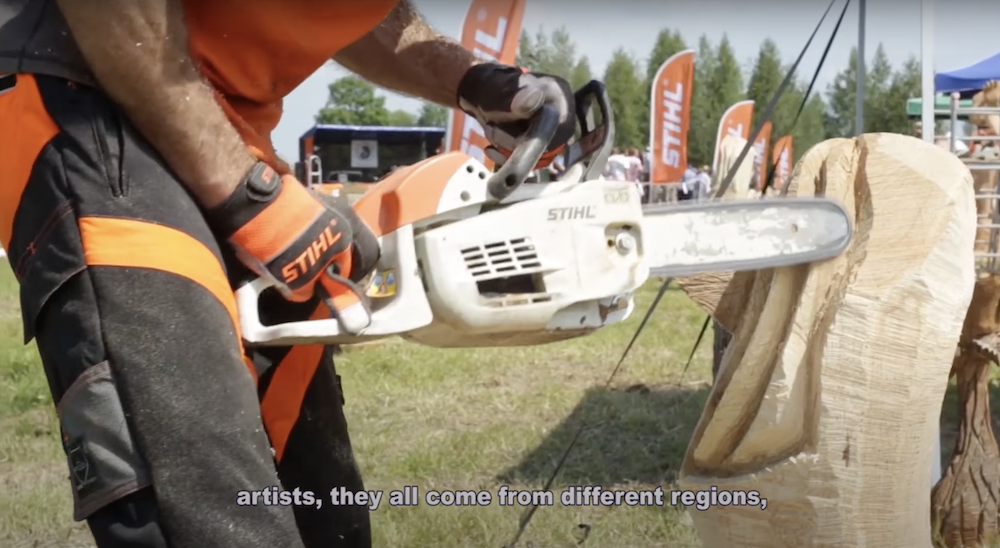
Anastasia Sosunova, Agents, 2020 (still). Video, color, sound; 14:57 min. Courtesy the artist. Video commissioned for “Roots to Routes,” 2020, curated by Juste Kostikovaite, Maija Rudovska and Merilin Talumaa, with the support of the Baltic Culture Fund.
In the car, the pair seems intent on encountering what Sosunova describes as a “Golem” or “Cyclopse-like” living version of Lithuanian wooden folk sculpture: the embodiment of tradition taking on a life of its own after it is created. According to the sculptor, the original inanimate wooden folk sculptures are left in the forest every year following a week-long festival for which people come from all different regions to carve traditional wooden folk sculptures in the shapes of different woodland creatures, religious figures, or folkloric characters, and have them judged. After the festival they are abandoned in the forest, and because of this tradition, the forest is now filled with mythical man-made creatures.
But, is tradition good or bad? The interviewer (assumed to be Sosunova) proposes, “I am interested, you know, in learning how much we can give up primary meanings that are in these images, and how much the symbols themselves control us if we use them thoughtlessly…for instance, Ancient Greek legends about Cyclops were born after the Greeks found old elephant skulls who used to inhabit that peninsula, and thought those were one-eyed giants that actually lived there. This is how I also thought about the Lithuanian tradition of devil depiction, it is so mystified, but in fact it is for the most part an iconography of anti-Semitism. What should we do with those images?” The film examines where both religious and secular symbols come from, who is creating what, why, when, and for whom.

Anastasia Sosunova, Agents, 2020 (still). Video, color, sound; 14:57 min. Courtesy the artist. Video commissioned for “Roots to Routes,” 2020, curated by Juste Kostikovaite, Maija Rudovska and Merilin Talumaa, with the support of the Baltic Culture Fund.
Later in the script, the sculptor shares a more vulnerable side of himself, adding another layer of openness and universality to the video. He comments, “Well, a few hundred years ago, when creating those folk sculptures, no one thought about traditions, a person did something from the heart. If a person creates a thing from the heart today, then after a few years there will be a tradition of some sort. The most important thing to do is make it from the heart. In the past, I was more critical, when I was younger, but now I think – let people make what they need. Sure, I don’t like it when people fool around, when it starts being all about fooling around it’s irritating. But otherwise, let the people do their thing, not my business, whatever people like should exist.” There is a relatable realness and resignation in this statement that rings very true after (and arguably unfortunately still during) the global pandemic, like a prophecy of the post(?)-pandemic art world: “Sure, I don’t like it when people fool around, [but]…whatever people like should exist,” with haunting simplicity.
The cloudy atmosphere and muted color palette of the setting of the video evoke an overall greyness, which reminds me of the abundance of grey architecture in Eastern Europe and the lingering evidence of communism and former Soviet control. However, with “Agents”, Sosunova emphasizes there is magic emerging within this greyish environment. What is unknown is if it is light or dark magic. To what extent are Sosunova’s CGI golems of tradition benign or treacherous? And what is the artist’s responsibility in the face of them?
The overall feeling of not being able to know what time of day it is in the video is also compelling. The setting seems to transition at different points from morning to afternoon, to twilight, in no particular order. There’s an oneiric sense of space and time throughout the film, enhanced by the abrupt stopping and starting of hypnotic video game music featuring tracks by Sro and Blear Moon.
Visitors to The New Museum will note Sosunova’s CV to date comprises mostly exhibitions in Lithuania, Estonia, and Latvia. It’s incredible to see great emerging art like Sosunova’s from other global regions, here New York. The experience of this video is at once very familiar and an immersion into Lithuanian subconscious.
“Agents”, 2020 by Anastasia Sosunova is on view at The New Museum from 30 June – 22 August, 2021. WM
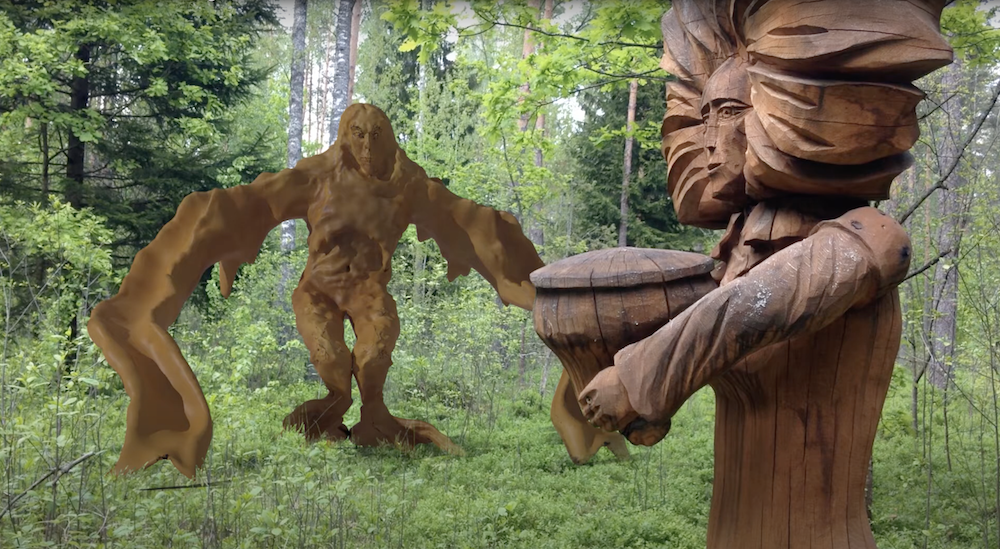
Anastasia Sosunova, Agents, 2020 (still). Video, color, sound; 14:57 min. Courtesy the artist. Video commissioned for “Roots to Routes,” 2020, curated by Juste Kostikovaite, Maija Rudovska and Merilin Talumaa, with the support of the Baltic Culture Fund.
